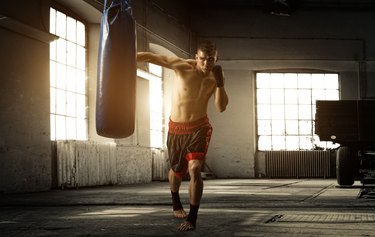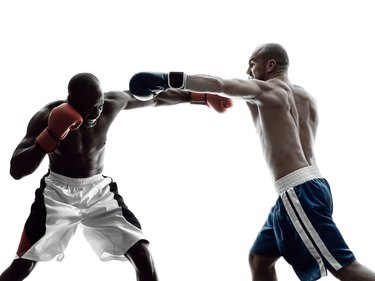
When you watch a boxing match, you see a flurry of fists and constant movement with the head and shoulders, whether the fighter is throwing or dodging punches. Most of the action happens above the waist, especially with the arms and fists. Meanwhile, you may not realize that the boxer's legs are churning underneath, powering each movement.
Leg strength is important in boxing for punching power and movement around the ring. Rarely, if ever, do boxers stand still. They're constantly on the go, attacking and defending. That means their legs almost never get a break. While the upper body muscles are important, they don't generate as much of the force for a punch, according to a 2014 study in Annals of Sports Science.
Video of the Day
Video of the Day
Difference Between Punches
Punching power is derived at first from leg drive. The amount of power the legs contribute depends on the punch thrown. The jab, which is the straight-forward punch performed with the non-dominant hand, is an abbreviated motion. Your back leg contributes to the punch by driving your body forwards.
The cross is a more powerful punch and utilizes more leg power than the jab. To perform a cross, you punch straight forward with your dominant hand. In a boxing stance, your dominant foot is behind your non-dominant, so that you have to turn your body towards your non-dominant side to throw the punch.
Turning into the punch is what gives you extra power, according to a 2017 study in the Journal of Physical Education and Sport. Your legs generate power from the ground up and transfer it up your body to your fist, following the body mechanics known as the kinetic chain.
Read more: How to Become More Physically Fit for Boxing
Kinetic Chain
Force travels through a chain in your body. That chain is made up of a series of joints and muscles, each of which contributes to the movement. For a punch, the kinetic chain starts down at your foot and runs all the way up to your fist.
To start, you drive your back foot into the ground. Ground reaction force pushes your body in the opposite direction — as you drive your foot down and backwards into the ground, the ground pushes you up and forwards.
Taking that energy and momentum from the ground, your body adds to the force as your progress up the chain. The muscles in your legs, hips, core and upper body all contribute until, finally, the force travels out through your fist.
It may seem like your leg doesn't move much when you punch, but that's what makes the kinetic chain so powerful. Imagine someone using a whip. He holds the handle and, with a small movement of the arm, creates a wave that travels down the whip. As the wave travels down it gets bigger and faster until it reaches the end and snaps.
Your legs are important because they start the chain reaction. The stronger they are, the more force you with which you have to work. Think of leg strength in boxing like the foundation of a house. It's much easier to build on a strong foundation than a weak one.

Leg Strength Specificity
Keep in mind that boxing is a weight class sport. That makes gaining muscle more troublesome because you have to do it sparingly. Gaining too much muscle can push you over the edge of your weight class and force you to fight with bigger opponents. To be strategic with your muscle gain, it can help to focus on building up your legs.
Read more: Lifting After Boxing
Skill Level
As you get better at boxing, the amount of leg drive that you use in a punch increases. A 2013 study in the Journal of Strength and Conditioning Research found that experienced boxers use their legs to drive 38.6 percent of the force in their punches. Intermediate level boxers legs provide 32.2 percent of their power, while novices use only 16.5 percent.
The disparity is probably due to the fact that using your arms to punch can tire them out quickly because they have to do all of the work. Let your legs contribute as much as possible, then add the core and upper body muscles to the mix to be an efficient boxer.
- Journal of Strength and Conditioning Research: Predicting Punching Acceleration From Selected Strength and Power Variables in Elite Karate Athletes: A Multiple Regression Analysis
- Journal of Physical Education and Sport: Kinematic and kinetic analysis of throwing a straight punch: the role of trunk rotation in delivering a powerful straight punch
- Expert Boxing: Most Important Muscles For Fighting
- Sports Health: The Kinetic Chain in Overhead Pitching